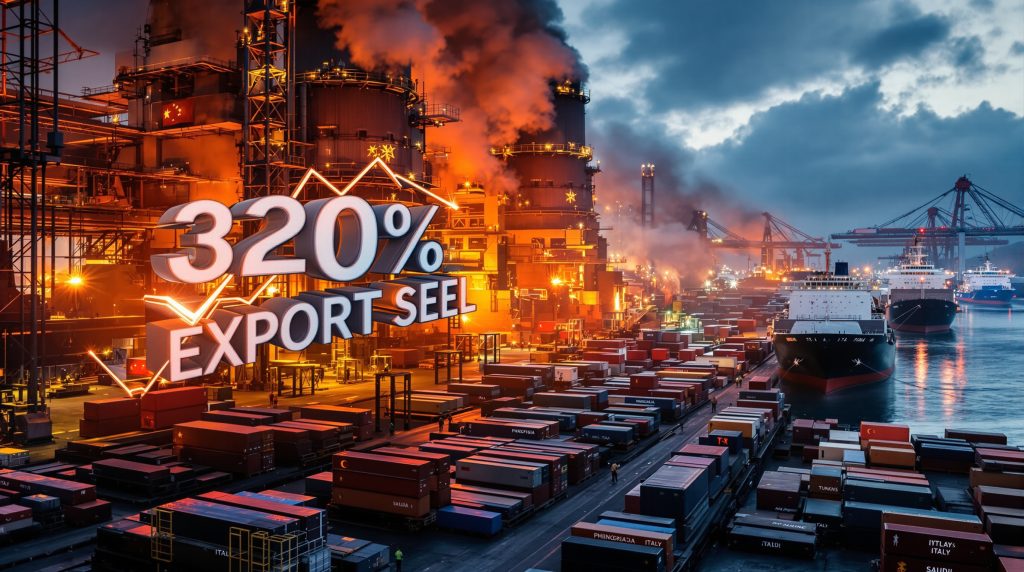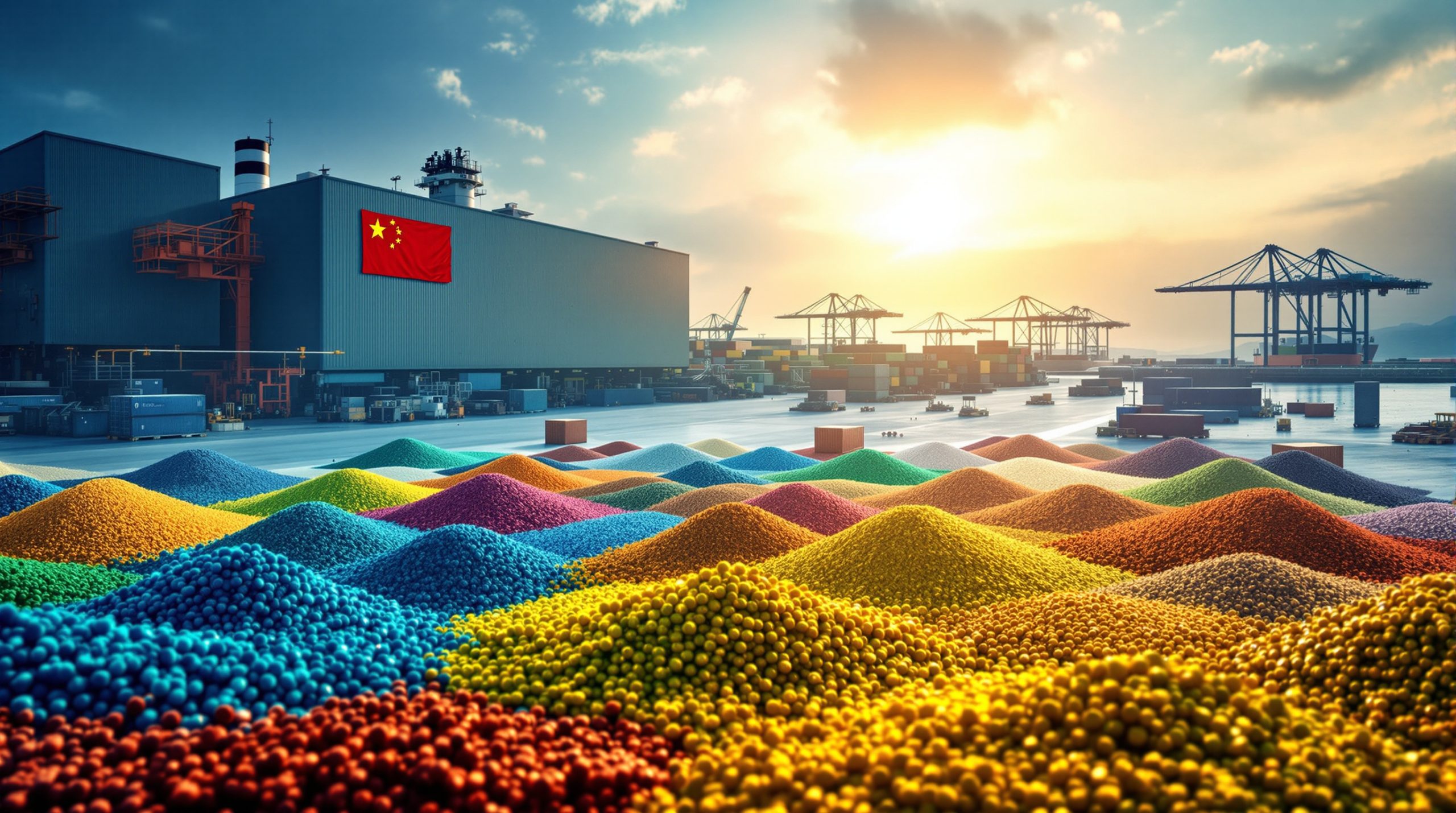China's Steel Export Strategy Evolution in 2025
China's semi-finished steel exports have undergone a remarkable transformation in 2025, with volumes increasing by an unprecedented 320% in the first seven months of the year. This strategic shift represents a significant adaptation to changing global trade dynamics and domestic economic pressures, particularly as China's steel industry navigates both international trade barriers and internal market challenges.
The surge in semi-finished steel exports has reached 7.4 million tons between January and July 2025, according to Chinese customs data analyzed by industry experts. July 2025 alone saw more than 1.5 million tons exported, representing approximately 14% of China's total steel shipments to global markets—a substantial increase from historical norms.
This dramatic export growth signals a fundamental shift in China's steel industry strategy, moving away from traditional finished products toward intermediate materials that face fewer trade restrictions globally. Furthermore, understanding current iron ore trends is essential for comprehending the full impact of this export surge.
Key Export Growth Statistics
- 7.4 million tons of semi-finished steel exported (January-July 2025)
- 320% year-on-year increase in semi-finished steel exports
- 1.5+ million tons exported in July 2025 alone
- Semi-finished exports now represent approximately 14% of total steel shipments
This export surge comes amid record-breaking overall steel exports from China in Q2 2025, helping to support a domestic market struggling with prolonged weakness in the property sector. The resilience demonstrated by Chinese steel traders highlights their ability to adapt to changing market conditions and navigate complex international trade environments.
Primary Export Destinations
| Country/Region | Volume (Jan-Jul 2025) | Market Position |
|---|---|---|
| Indonesia | 1.14 million tons | Leading importer |
| Philippines | Just under 1 million tons | Second largest market |
| Turkey | Significant volume | Growing market |
| Italy | Significant volume | Key European destination |
| Saudi Arabia | Significant volume | Emerging Middle East market |
Industry analysts note that this strategic pivot allows Chinese steel manufacturers to maintain production volumes despite weakened domestic demand and increasing trade barriers against finished steel products.
What Are Semi-Finished Steel Products and Why Do They Matter?
Semi-finished steel products represent an intermediate stage in steel production that requires further processing before reaching end-users. These products serve as the foundation for a wide range of downstream manufacturing applications across industries like construction, automotive, and infrastructure development.
Understanding the nature of these intermediate products provides crucial context for appreciating the significance of China's export strategy shift and its implications for global steel markets.
Types of Semi-Finished Steel Products
-
Steel billets: Rectangular semi-finished products typically used for further rolling into bars, rods, and sections. These versatile products serve as the raw material for many construction-related applications.
-
Steel slabs: Flat, wide semi-finished products that serve as precursors for flat steel products like plates and sheets. These are crucial inputs for industries requiring flat steel components, including automotive manufacturing, shipbuilding, and appliance production.
-
Steel blooms: Larger cross-section semi-finished products often used for heavy structural sections. These products typically undergo further processing to create specialized structural components for major infrastructure projects and industrial applications.
Each of these product categories represents a different stage in the steel production value chain, with distinct applications and market dynamics.
Strategic Importance in Global Trade
-
Require less processing than finished products, reducing export costs and increasing competitiveness in price-sensitive markets
-
Face fewer trade restrictions compared to finished steel products, allowing exporters to circumvent anti-dumping measures and other trade barriers
-
Enable value addition in importing countries through further processing, creating economic opportunities for local manufacturers
-
Provide flexibility in meeting varying market demands across different regions and industry sectors
The growing importance of semi-finished steel in global trade represents a fundamental restructuring of steel supply chains, with significant implications for producers, processors, and consumers worldwide.
Why Is China Dramatically Increasing Semi-Finished Steel Exports?
The surge in China's semi-finished steel exports stems from a complex interplay of domestic challenges and international trade dynamics that have forced the industry to adapt its export strategy. This shift represents both a response to immediate market pressures and a strategic repositioning within the global steel landscape.
Domestic Market Pressures
-
Prolonged weakness in China's property sector limiting domestic demand for steel products, creating inventory challenges for manufacturers
-
Excess production capacity creating inventory pressures that threaten industry profitability and stability
-
Need to maintain production levels despite weakened internal consumption to preserve jobs and economic activity in steel-producing regions
-
Economic imperative to sustain employment in steel-producing regions, which remain vital to China's industrial economy
These domestic factors have created a strong incentive for Chinese producers to seek alternative markets for their output, particularly as local demand fails to absorb available production. Additionally, the iron ore demand insights reveal how this export strategy is influencing raw material markets.
Trade Barrier Navigation
-
Growing global protectionism against Chinese finished steel products, including significant anti-dumping measures in key markets
-
Anti-dumping measures specifically targeting hot-rolled coil, resulting in a 13% decline in these exports during 2025
-
Strategic pivot to less-regulated semi-finished products that face fewer restrictions in international markets
-
Ability to circumvent country-specific trade restrictions on finished goods by shifting to intermediate products
The adaptability demonstrated by Chinese steel exporters highlights the industry's strategic agility in responding to changing trade environments. As regulatory pressures have increased on traditional export products, the industry has successfully identified and developed alternative market channels.
According to industry analysts, this export strategy is likely to persist as long as China maintains its price competitiveness in semi-finished products and domestic demand remains insufficient to absorb production.
How Are Global Markets Responding to China's Export Surge?
The flood of Chinese semi-finished steel products is creating ripple effects throughout global markets, with varied responses from different stakeholders across the steel value chain. This unprecedented export volume is reshaping trade patterns and competitive dynamics in key steel-consuming regions.
Regional Market Impacts
-
Southeast Asian processors benefiting from lower-cost input materials, particularly in Indonesia (1.14 million tons) and the Philippines (nearly 1 million tons)
-
Middle Eastern construction sector gaining access to more affordable steel resources, with Saudi Arabia emerging as a significant importer
-
European manufacturers facing increased competition from Chinese semi-finished imports, with Italy among the top destination markets
-
Potential processing capacity utilization increases in importing countries, stimulating local finishing operations
These regional impacts reflect the complex ways in which China's export surge is reshaping global steel market dynamics, creating both opportunities and challenges for different market participants. The tariff impact on markets further complicates this landscape for international traders.
Industry Concerns and Reactions
-
China Iron and Steel Association proposing export curbs on billets, reflecting internal debate about the optimal strategy for the industry
-
Domestic processors concerned about lost value-addition opportunities as semi-finished products are processed abroad
-
Arguments that the trade "wastes domestic processing capacity" by exporting products before maximum value has been added
-
Concerns about maintaining high iron ore prices due to continued strong production despite weak domestic demand
The varied reactions across different stakeholders highlight the complex trade-offs involved in China's evolving export strategy. While the approach helps maintain production volumes and export revenues, it raises questions about long-term industry development and resource utilization.
What Are the Long-Term Implications for Global Steel Markets?
The structural shift in China's steel export strategy carries significant implications for the future of global steel trade, resource utilization, and market dynamics. This transformation is likely to trigger adaptations throughout the global steel ecosystem as markets adjust to new trade patterns.
Potential Trade Policy Developments
-
Possibility of new trade barriers specifically targeting semi-finished products as importing countries seek to protect domestic industries
-
Risk of escalating global protectionism in the steel sector as trade tensions increase
-
Potential for trade negotiations focusing on steel intermediate products, similar to previous discussions on finished goods
-
Likelihood of continued adaptation by Chinese exporters to find market access despite evolving trade restrictions
These policy dynamics will significantly influence how sustainable China's current export strategy proves to be over the longer term. The global tariff effects are creating additional complexity in this evolving situation.
Supply Chain Restructuring
-
Shifting of steel finishing operations to countries receiving Chinese semi-finished exports, potentially creating new processing hubs
-
Development of new processing hubs in Southeast Asia and the Middle East to capitalize on available semi-finished inputs
-
Potential vertical integration by major steel consumers to capitalize on lower-cost inputs from China
-
Reconfiguration of global steel value chains based on trade policy environments and regional manufacturing advantages
The long-term impacts of these shifts could fundamentally alter the global steel industry structure, potentially accelerating the development of regional processing capabilities and changing traditional patterns of steel trade.
How Does the Export Surge Affect Iron Ore Markets?
The continued high production levels in China necessary to support export volumes have significant implications for iron ore demand and pricing dynamics. Despite weakened domestic consumption, China's steel industry continues to require substantial raw material inputs to maintain export-oriented production.
Iron Ore Demand Factors
-
Sustained high steel production levels despite domestic market weakness, supporting consistent demand for iron ore imports
-
Export-driven production maintaining strong iron ore import requirements, influencing global supply-demand balance
-
Potential for continued price support in iron ore markets due to China's production needs
-
Strategic importance of securing iron ore supplies for export competitiveness in semi-finished products
As noted by industry observers, the continuation of semi-finished steel exports "keeps iron ore prices high" by maintaining demand for this critical raw material despite weakened domestic consumption of finished steel products.
Resource Utilization Considerations
-
Environmental impact of maintaining high production for export markets, raising questions about carbon emissions and sustainability
-
Energy consumption implications of steel production for foreign processing, particularly as China works to meet climate goals
-
Resource efficiency questions regarding semi-finished exports versus domestic processing to maximize value creation
-
Sustainability considerations in global steel value chains as production and processing become increasingly separated geographically
These resource utilization factors raise important questions about the long-term sustainability of current production and trade patterns in the global steel industry.
What Are the Competitive Advantages Driving China's Export Success?
China's ability to dramatically increase semi-finished steel exports despite global headwinds stems from several structural competitive advantages in its steel industry. These advantages have enabled Chinese producers to remain highly competitive in international markets despite increasing trade restrictions.
Cost Structure Advantages
-
Scale economies from the world's largest steel production base, allowing for efficient large-scale operations
-
Lower energy and labor costs compared to many competing producers, creating fundamental cost advantages
-
Advanced production technologies enabling cost-effective manufacturing of semi-finished products
-
Integrated supply chains reducing logistics and raw material costs through optimization and coordination
According to industry analysts, "China is very price competitive" in billet exports, enabling continued market penetration despite increasing global protectionism. This competitiveness also influences US-China trade strategies in the broader economic relationship.
Market Adaptation Capabilities
-
Agile response to changing trade barriers and market conditions through strategic product shifts
-
Sophisticated trading networks with global reach, facilitating market development in diverse regions
-
Strategic pivoting between product categories based on market access and trade policy changes
-
Experience navigating complex international trade environments, allowing for rapid adjustment to new restrictions
These adaptation capabilities have been clearly demonstrated in the steel industry's pivot from finished products facing anti-dumping measures to semi-finished products with fewer trade restrictions.
FAQs About China's Steel Export Surge
Why are semi-finished steel exports growing while finished product exports face challenges?
Semi-finished steel products often face fewer trade restrictions and anti-dumping measures compared to finished products like hot-rolled coil. This regulatory gap has created an opportunity for Chinese exporters to maintain volume by shifting to intermediate products that can be further processed in destination markets. Hot-rolled coil exports, for example, declined by approximately 13% in 2025 due to trade barriers, while semi-finished exports surged by 320%.
What impact might this export surge have on global steel prices?
The flood of semi-finished steel from China is likely to exert downward pressure on global steel prices, particularly in regions receiving significant volumes. This could benefit steel-consuming industries but create challenges for steel producers in importing countries who must compete with lower-cost Chinese material. The price impact varies by region and product category, depending on local supply-demand dynamics and trade policy environments.
How sustainable is this export strategy for China's steel industry?
The strategy faces potential long-term challenges, including the possibility of new trade barriers specifically targeting semi-finished products, domestic industry concerns about lost value-addition opportunities, and questions about resource efficiency. Its sustainability will depend on China's ability to continue adapting to evolving trade environments. Internal debates within China's steel industry about the wisdom of this approach highlight the complex considerations involved.
What are the implications for steel producers in other countries?
Steel producers in other countries may face increased competitive pressure, particularly those selling into markets now receiving Chinese semi-finished products. However, processors capable of further transforming these semi-finished imports may benefit from lower input costs, potentially creating new business opportunities. The differentiated impact across various segments of the steel value chain explains the varied reactions to China's export surge.
Further Exploration
Readers interested in learning more about global steel trade dynamics can explore related educational content, such as the article "China's steel exports rise in July despite protectionist backlash" on Reuters, which offers additional perspectives on China's evolving steel export strategies.
Industry observers should continue monitoring developments in trade policy, market responses, and industry adaptation as this significant shift in global steel trade patterns continues to unfold throughout 2025 and beyond.
Ready to Spot the Next Mining Opportunity Before the Market?
Discover how traders identify significant ASX mineral discoveries before they make headlines with Discovery Alert's proprietary Discovery IQ model, providing real-time notifications that transform complex data into actionable insights. Begin your 30-day free trial today at Discovery Alert to position yourself ahead of the market.




